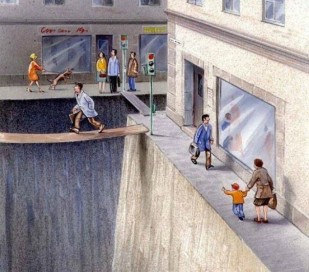City forges a better path with Complete Streets Framework

Pedestrian Street. Illustration by Karl Jilg.
Earlier today, Vancouver City Council met to discuss a proposed Framework – presented by Engineering staff for informational purposes – on Complete Streets – “designed for all ages, abilities, and modes of travel,” and where “safe and comfortable access for pedestrians, bicycles, transit users and people with disabilities is not an afterthought, but an integral planning feature.” (See the Complete Streets for Canada website for more background).
In our opinion, the proposed Framework actually helps to ground earlier policy found in the City’s Transportation 2040 Plan (2012), it’s Renewable City Strategy (2015), and, more recently, neighbourhood planning initiatives such as the Grandview-Woodland Community Plan (2016). Still, despite the fact that the Complete Streets approach makes a lot of sense (for health, safety, economy and environment… to name just a few of the reasons), the concept is still one that has generated debate in some neighbourhoods.
With that in mind, we took the opportunity to write to Mayor and Council, again offering our support for this work – along with a few suggestions on ways to tighten up the document. An excerpt of our letter follows.
[We are] writing … to offer our support – and three suggestions – related to the Complete Streets Framework.
As an organization, we believe wholeheartedly in the idea of streets as places – that is, streets that are as much about getting from point A to point B, as they are about opportunities for lingering, gathering, strolling, people-watching and more. Given that the average city devotes about a third of its land base to its street network, this makes the question a particularly significant one from a public space perspective.
The idea of “complete streets” is not new. Cities around the world are taking a second look at how streets are being used, how different modes of transportation are emphasized (or not), and what this means for questions of equity around the allocation of space. One of the key realizations is that, in many cases, the scales have been tipped disproportionately in favour of automobile use. The challenge this poses for pedestrians is illustrated rather poignantly by Swedish artist Karl Jilg (see feature image).
The same sort of illustration might also be rendered for cyclists or public transit users.
We support the Complete Streets approach because we think it helps address a fundamental question of rebalancing road space. We want to be clear about one thing though: this is not an “anti-car” stance; rather it is a pro-equity position.
However, we would offer the following suggestions for improving the Framework and Principles discussed in the Council report:
- Further emphasize the importance of streets as public space. This principle needs to foreground the discussion – because this ensures that streets are seen as sites of vibrant cultural possibility and thriving public life.
- Ensure a specific reference to supporting goals of social justice. Complete Streets need to be accessible and inclusive to everyone – regardless of economic status, life circumstances, etc. The phrase “all ages and abilities” only goes part way to meeting this need – particularly in a city were more people are on the streets because that is the only choice they have.
- Include reference to the support system that enables streets to function as public places. Complete streets need seating, water fountains, bathrooms, weather protection, and other infrastructure to support public life.
To this end, we wish to reiterate our support for the City’s work to support Complete Streets policy on Commercial Drive (Grandview-Woodland Plan), in the new False Creek Flats Plan, and in other planning programs currently underway.
Lastly, we recognize that re-balancing the scale towards a more just allocation of road space will take many years, requiring both incremental improvements on some streets and more significant design changes on other streets. We are in support of associated changes to the Street and Traffic By law, where they help facilitate local and incremental improvements, advancing towards a more complete street network. This can help enable and expedite infrastructure improvements dedicated to people walking, taking transit and cycling. These activities, however, should always be done in consultation with the local community and other stakeholders that may be affected.